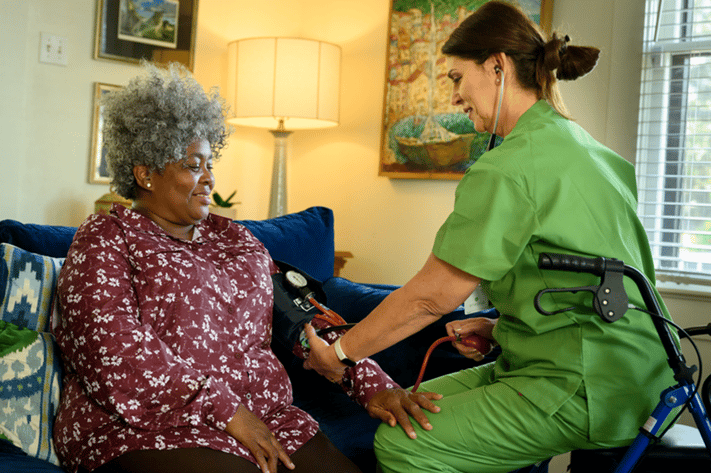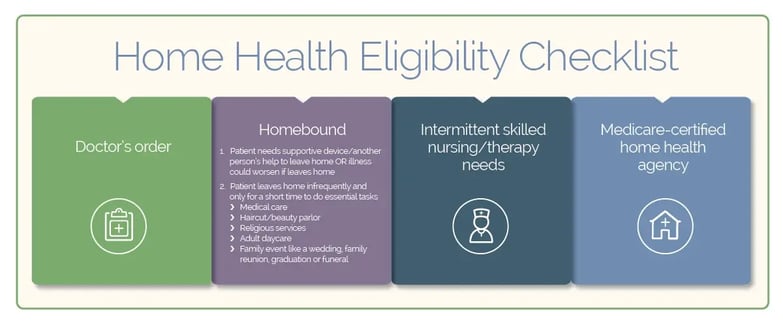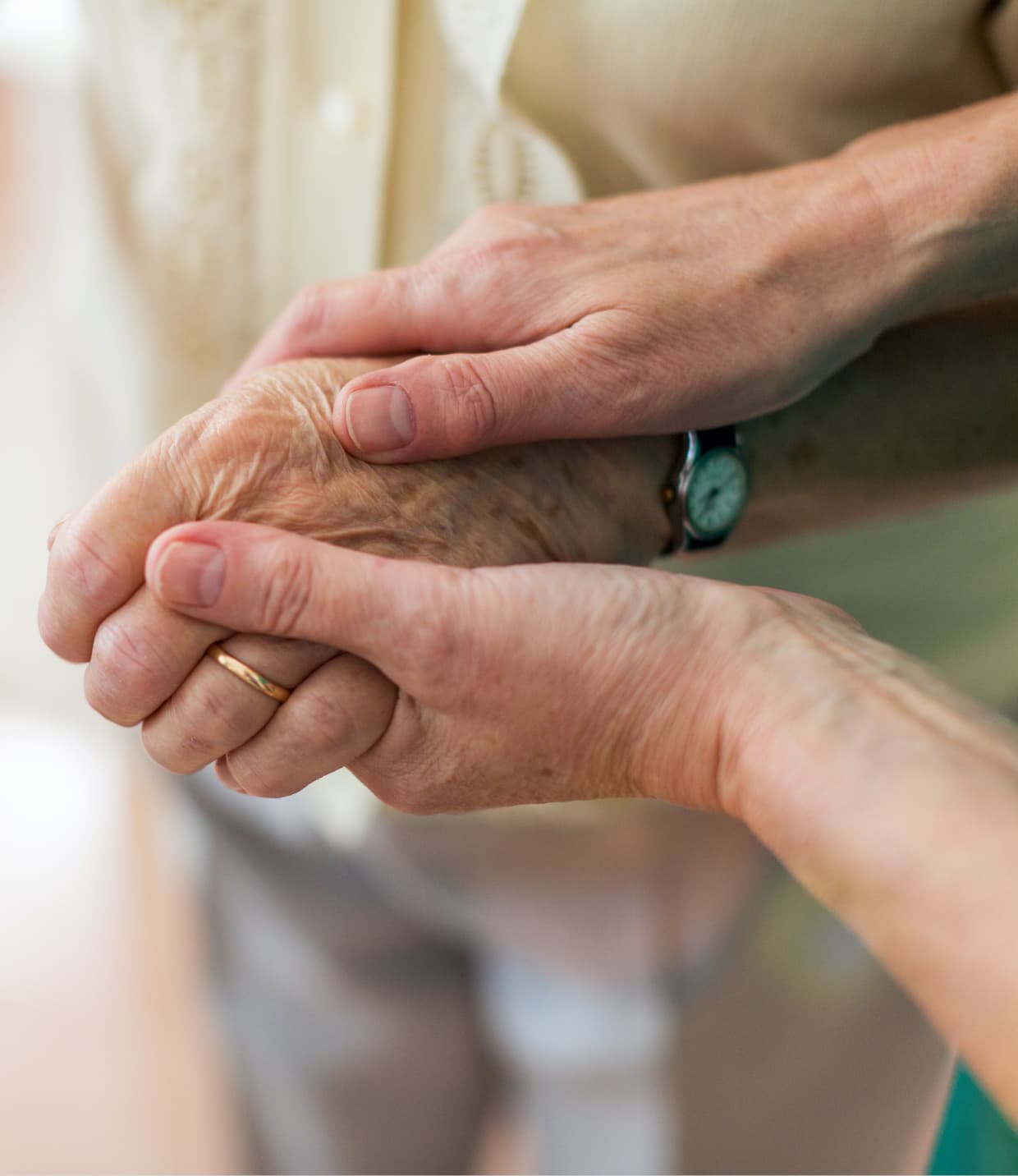Home health and hospice are two options for healthcare at home that provide very different types of care. Comparing home health vs. hospice will help you understand which type of care matches your needs. So, what is the difference between hospice and home health?
The main difference between hospice and home health is that hospice is for people with a terminal illness who aren’t expected to live longer than six months, and who have elected to forgo curative treatment. Home health is for people who need help recovering from an illness, injury or surgery or managing a chronic health condition. There are also differences in the services provided, eligibility criteria, visit frequency, location and the team providing care.
The Differences: Home Health vs. Hospice
Let’s take a closer look at some of the key differences between hospice and home health care, including what services they provide, how eligibility is determined, whether they are covered by insurance and more.
Definition of Services
- Home health care helps people recover from illness, injury or surgery. It also helps people learn to manage chronic health conditions.
- Hospice care provides pain and symptom management for people with a terminal illness and a life expectancy of six months or less if the illness runs its normal course, who have elected to forgo curative treatment.
%20(1200%20x%203000%20px)%20(3).jpg?width=558&height=1102&name=Blue%20and%20White%20Modern%20Simple%20Computer%20Comparison%20Infographic%20(1200%20x%202000%20px)%20(1200%20x%203000%20px)%20(3).jpg)
Home Health Services
Home health care refers to skilled medical, therapy services and supportive non-medical services provided in a person’s residence, under the direction of a physician tailored to the individual’s health needs.
The goal of this care is to keep patients out of the hospital and safe at home. Home health services address intermittent, or periodic needs, and may include:
- Skilled nursing
- Physical therapy
- Occupational therapy
- Speech therapy
- Medical social work
- Help with personal care from a home health aide, as needed

Benefits of Home Health Care
The services provided to patients through home health care have been shown to have positive impacts, including increased patient satisfaction, better quality of life and improved medication adherence. 1
Hospice Services and Benefits
Hospice care focuses on comfort and quality of life, by providing services to patients who have chosen to stop curative treatment and focus instead on improving symptoms. Hospice services include:
- Skilled nursing
- Help with personal care from a home health aide
- Medical social work to help with planning, insurance, advance directives and other concerns
- Bereavement counseling for loved ones
- Spiritual counseling with a chaplain
- Trained volunteers to assist with household tasks, errands, preparing meals and providing companionship
Benefits of Hospice Care
Hospice services provide several benefits to people at the end of life, and to their families as well. Like home health care, it can help improve quality of life. It also offers unique support during this difficult period, including:
- Helping people meet their unique goals at the end of life
- 24/7 support from clinical staff for any urgent needs
- Respite care for up to five days at a time
- Reducing unnecessary visits to the hospital
- Bereavement support for families for at least 13 months following a person’s death
- Spiritual support if desired
- Affordability, with eligible services covered 100% by Medicare and most other insurance
Eligibility for Services: Home Health vs. Hospice
To qualify for home health care coverage, patients have to meet certain eligibility criteria. For example, they must be considered homebound, which means they have limited ability to leave their home without help.
Hospice has different eligibility criteria. A doctor must determine that the patient has six months or less to live if their illness follows its usual course, and the patient must be ready to stop curative treatments. Hospice patients do not have to be homebound.

Insurance Coverage
-
- Home health is typically covered by Medicare, Medicaid and some private insurance plans for eligible patients. Medications are not covered under Medicare, and medical equipment and supplies may be covered at 80% under Medicare Part B. 2
- Hospice is also covered by Medicare, Medicaid and most private insurance plans for eligible patients. Medicare covers medications, medical equipment and supplies related to the terminal diagnosis.
Care Teams
The home health team is made up of:
- Nurses
- Physical therapists
- Speech language pathologists
- Occupational therapists
- Medical social workers
- Home health aides
- In some cases, behavioral health nurses
The hospice care team is made up of:
- Nurses
- Social workers
- Home health aides
- Chaplains
- Bereavement counselors
- Trained volunteers
Frequency and Length of Care
- Home health care visits are based on the needs of the patient and caregiver. They typically decrease over time as the patient’s health improves and their needs decrease. The patient receives visits on an intermittent basis for as long as they meet eligibility criteria and their doctor deems care medically necessary.
- Hospice care visits are also based on the needs of the patient and caregiver. They typically increase over time, as the patient’s health declines and their needs increase. The patient can receive visits for six months or longer if a doctor certifies they continue to have a limited life expectancy.
Goals of Care
- The primary goal of home health care is to help the patient recover or maintain their current level of functionality.
- The primary goal of hospice care is to promote quality of life and manage pain and other symptoms to promote a safe, peaceful dying experience.
Where You Can Receive Home Health Care
Patients can receive home health care in their home. This can include a private residence, assisted living and group homes. It cannot be provided in most inpatient settings, like a hospital or nursing home.
Where You Can Receive Hospice Care
Patients may receive hospice care wherever they call home. Depending on the level of care needed, this can include a private residence, a facility, an inpatient hospice center and short stays in an inpatient hospital setting.
The Four Levels of Hospice Care
There are four different levels of hospice care: 3
- Routine care is provided wherever the patient calls home.
- Respite care places the patient in a Medicare/Medicaid contracted care facility for five days and five nights to provide relief to the caregiver.
- Continuous Home Care is provided in the home during a period of crisis. It includes at least 8 hours of care in 24-hour period provided by nursing and home health aide services.
- General Inpatient Care is provided during a period of crisis when symptoms cannot be managed at home. The patient is admitted to a Medicare/Medicaid contracted facility and hospice works with the facility to manage their symptoms.

The Similarities: Home Health vs. Hospice
To understand the difference between home health and hospice, it helps to know the similarities. Both types of care:
- Can be provided in the comfort and safety of home
- Are covered by Medicare, Medicaid, the Veterans Administration and many private insurance companies
- Require a doctor’s order, based on eligibility criteria
- Help older adults stay as independent as possible
- Provide help with tasks like bathing, dressing and grooming, depending on the patient’s needs
- Are less expensive than hospital or facility care
- Continue as long as your doctor certifies, and you continue to meet eligibility requirements
- Are provided by interdisciplinary teams
- Typically involve visits a few hours per week, depending on the patient’s needs and doctor’s orders, with most day-to-day care provided by a family member or caregiver
When you’re comparing home health care vs. hospice care, you should know that both are part of a continuum of care. People receiving home health care might transition to hospice if their condition worsens. Patients receiving hospice may transition to home health if their condition improves enough that they are no longer eligible for hospice.
In some situations, patients can receive home health and hospice at the same time. This may be an option if the patient meets the criteria for both services and needs care for a terminal illness as well as a condition that isn’t related to the terminal illness.
Although there are many differences between hospice care and home health care, both types of care can help older adults “age in place” in their homes. Ask your health care provider if home health or hospice care is an option for you. To learn more, call an Amedisys at-home care agency near you.
Carolyn Hartsfield, MBA, RN, serves as Assistant Vice President of Nursing Strategy Innovation Programs at Amedisys. With 30 years of nursing experience, including 28 years in the home health industry, Carolyn brings a wealth of expertise to the field. She is passionate about improving home health services and dedicated to making a lasting impact in the industry.
Deb Gallaher, MBA, MSN, RN, NE-BC, CHPN, is a Senior Hospice Clinical Education Specialist for Amedisys. She has 10 years of experience in hospice and is passionate about sharing her insights on high-quality care.
references |





